

Glossary. Users and other figures can become part of the design process as expert of their experience, but in order to take on this role they must be given appropriate tools for expressing themselves.

The designers should provide ways for people to engage with each other as well as instruments to communicate, be creative, share insights and envision their own ideas. The co-design activities can support different levels of participation, from situation in which the external figures are involved just in specific moments to situations in which they take part to the entire process, building up the service together with the designers. (2001) Elizabeth B. Lego serious play. LEGO Serious Play is an innovative, experiential process designed to enhance the generation of innovative solutions.
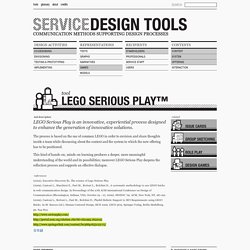
The process is based on the use of common LEGO in order to envision and share thoughts inside a team while discussing about the context and the system in which the new offering has to be positioned. This kind of hands-on, minds-on learning produces a deeper, more meaningful understanding of the world and its possibilities; moreover LEGO Serious Play deepens the reflection process and supports an effective dialogue. References: (2002), Executive Discovery llc, The science of Lego Serious Play. (2009), Cantoni L., Marchiori E., Faré M., Botturi L., Bolchini D., A systematic methodology to use LEGO bricks in web communication design. . (2009), Cantoni L., Botturi L., Faré M., Bolchini D., Playful Holistic Support to HCI Requirements using LEGO Bricks. LSP - Official.
Design games. Using Design Games - Boxes and Arrows: The design behind the des. If you’ve ever sat through a requirements workshop thinking it was wasted time, maybe you’re ready to take on some new tools to get what people really need out of their heads, and into the world.
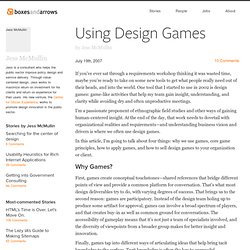
One tool that I started to use in 2002 is design games: game-like activities that help my team gain insight, understanding, and clarity while avoiding dry and often unproductive meetings. I’m a passionate proponent of ethnographic field studies and other ways of gaining human-centered insight. At the end of the day, that work needs to dovetail with organizational realities and requirements—and understanding business vision and drivers is where we often use design games. In this article, I’m going to talk about four things: why we use games, core game principles, how to apply games, and how to sell design games to your organization or client.
Why Games? First, games create conceptual touchstones—shared references that bridge different points of view and provide a common platform for conversation. Role playing. Some actors, the sample users or the designers themselves perform a hypotetical service experience.
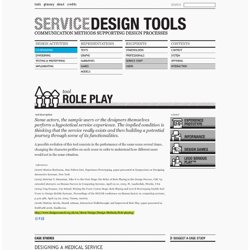
The implied condition is thinking that the service really exists and then building a potential journey through some of its functionalities. A possible evolution of this tool consists in the performance of the same scene several times, changing the character profiles on each scene in order to understand how different users would act in the same situation. References: (2000) Marion Buchenau, Jane Fulton Suri, Experience Prototyping, paper presented at Symposium on Designing Interactive Systems, New York. Method Cards - Case Studies - IDEO. IDEO Method Cards is a collection of 51 cards representing diverse ways that design teams can understand the people they are designing for.
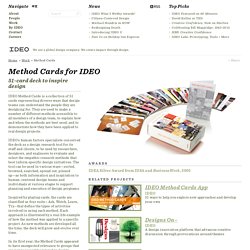
Group sketching. Issue cards. Rough prototyping. » PhotoCaring - Final GUI Presentation Adam Little @ CIID. PhotoCaring mockup As context for the Graphical User Interfaces course, we used the elderly home insights we discovered in our User Research course for developing concepts for the GUI final project.
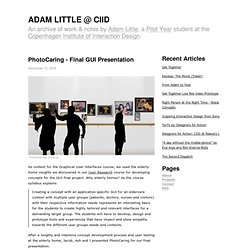
Why elderly homes? As the course syllabus explains: Creating a concept with an application specific GUI for an eldercare context with multiple user groups (patients, doctors, nurses and visitors) with their respective information needs represents an interesting basis for the students to create highly tailored and relevant interfaces for a demanding target group. How to Prototype: The Awesome Guide. This is a guest post from Lindsay Gordon, prototyping genious from South East Water.
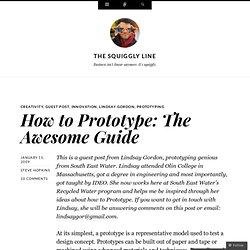
Lindsay attended Olin College in Massachusetts, got a degree in engineering and most importantly, got taught by IDEO. She now works here at South East Water’s Recycled Water program and helps me be inspired through her ideas about how to Prototype. If you want to get in touch with Lindsay, she will be answering comments on this post or email: lindsaygor@gmail.com. At its simplest, a prototype is a representative model used to test a design concept. Prototypes can be built out of paper and tape or machined using advanced materials and techniques. Why is prototyping useful? Affinity diagram. Improvement and Innovation. Denver, July 7, 2005 - Decisioneering, Inc., an innovator of software and services for risk analysis and optimisation, today announced that George Group, the leader in Lean Six Sigma, has joined Decisioneering’s Six Sigma Partner Program.
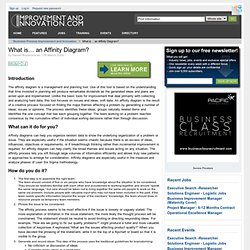
As a Six Sigma Partner, George Group will work with Decisioneering to promote the use of Crystal Ball simulation and optimisation tools throughout its Six Sigma initiatives. George Group is the leader in Lean Six Sigma and has been creating real economic value for Fortune 1000 clients for the past 19 years. George Group has supported more global Lean Six Sigma deployments than any other Six Sigma consultancy. As an innovator and leader in Lean Six Sigma, George Group is always looking for the best way to help its clients save money. 'The Fortune 1000 clients we serve demand the best software and tools in their Six Sigma operations, said James Works, president of George Group. Motivation matrix.
Visualization Tool - How communicate the service design concepts. Lolacases. Mind map. A Designer Takes on His Biggest Challenge Ever. David Kelley on human-centered design. Storyboard. Engine Service Design. Thinkpublic Comic « Design for Service. Storytelling. Prototyping Services with storytelling. Dave Chiu > RentAThing (with Orange) Project Details Brief The brief for this Applied Dreams project revolved around issues of identity and privacy in a world of ubiquitous information and access, specifically looking at social, political, and technological forces at work today and their effects on the future.
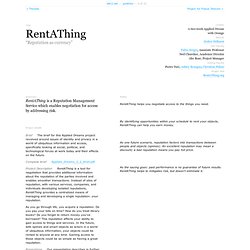
Complete brief Applied_Dreams_2_2_brief.pdf Project Description RentAThing is a tool for negotiation that provides additional information about the reputation of the parties involved and enables smoother transactions. Instead of silos of reputation, with various services, companies, and individuals developing isolated reputations, RentAThing provides a centralized means of managing and developing a single reputation: your reputation. As you go through life, you acquire a reputation. Presentions Our presentation describes in further detail several scenarios involving reputation management services, along with potential interfaces and some future opportunities.
You can view the presentation slideshow on Flickr. RentAThing: Applied Dreams 2.2 Presentation. Character profile.